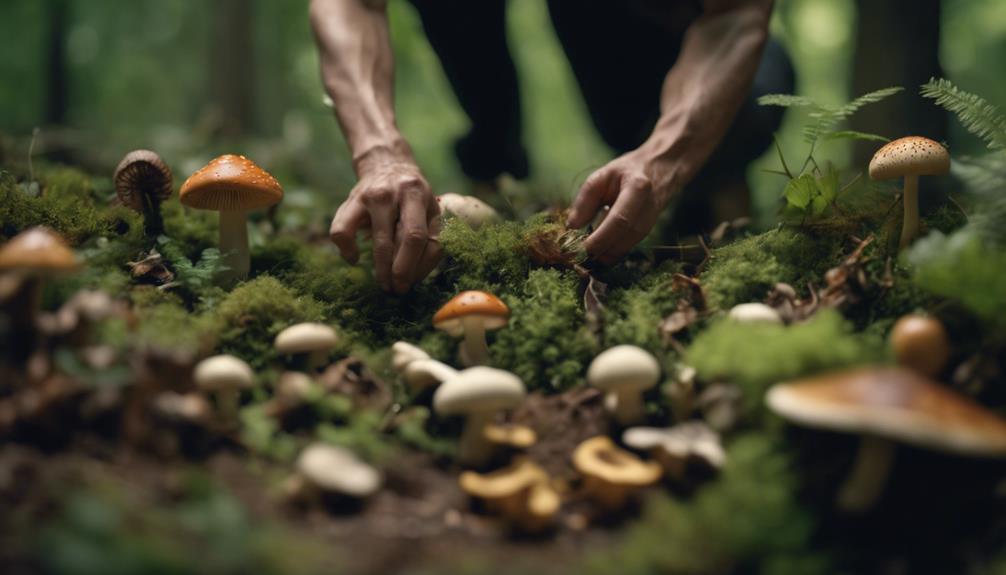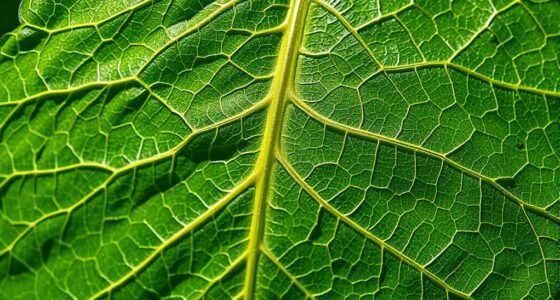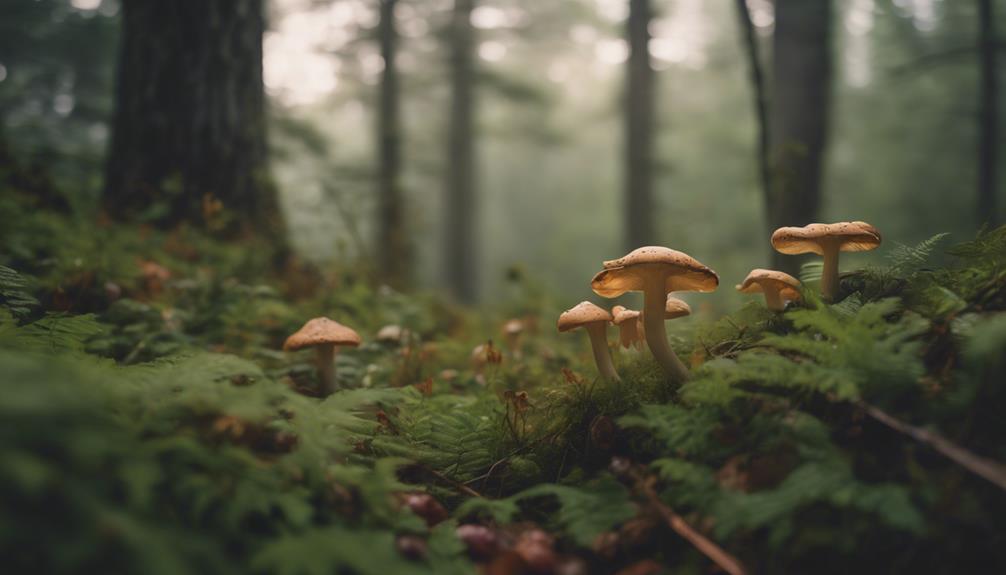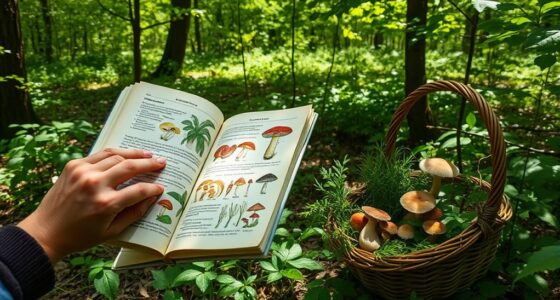Wisconsin's diverse landscape offers a treasure trove of over 400 wild edibles waiting to be uncovered. To forage like a pro, start by learning about one plant at a time, mastering its characteristics, and prioritizing safety. Carry essential tools, harvest sustainably, and respect private property. Properly identify wild edibles, avoid contaminated areas, and cook them thoroughly. As you explore Wisconsin's wild bounty, you'll discover ramps, fiddleheads, and wild asparagus, and experience the thrill of foraging. Now, take the next step and uncover the secrets of Wisconsin's edible landscape – and get ready to savor the flavor of the wild.
Key Takeaways
- Master one plant at a time to develop identification skills and ensure safe foraging in Wisconsin's wild bounty.
- Carry essential tools like a pocket knife, canvas bags, and gloves to efficiently harvest wild edibles.
- Prioritize sustainability by harvesting sparingly, respecting private property, and avoiding contaminated areas.
- Develop identification skills to distinguish edible species from toxic lookalikes, ensuring a safe foraging experience.
- Explore diverse landscapes in state parks, forests, and natural areas to find foraging opportunities while respecting private lands.
Wisconsin's Edible Landscape
As you explore Wisconsin's diverse landscape, you'll uncover a treasure trove of wild edibles waiting to be discovered. From the state's lush forests to its rolling hills, Wisconsin offers a vast array of native plants that aren't only delicious but also packed with nutrients.
However, it's important to be aware of the invasive species that can outcompete native plants, altering the ecosystem and potentially threatening the local biodiversity.
When foraging in Wisconsin, it's vital to identify the edible species correctly to avoid mistakenly consuming invasive or toxic lookalikes. Native plants like ramps, fiddleheads, and wild asparagus thrive in the state's diverse landscape, providing a bounty of wild edibles for you to discover.
Foraging 101: Getting Started

To get started with foraging, you'll need to learn the basics, from identifying wild edibles to understanding sustainable harvesting practices. Begin by focusing on one plant or mushroom species, and thoroughly understand its characteristics before expanding your foraging knowledge. As you venture out, carry basic foraging tools like a pocket knife, canvas bags, and gloves to guarantee a successful experience.
| Foraging Essentials | Tips and Reminders |
|---|---|
| Learn one plant at a time | Master its characteristics before moving on |
| Carry basic tools | Pocket knife, canvas bags, and gloves are must-haves |
| Harvest sustainably | Respect private property and leave no trace behind |
| Prioritize safety | Positively identify wild edibles and cook thoroughly |
| Know the environment | Avoid contaminated areas and support local ecosystems |
As you commence on your foraging journey, remember to prioritize safety and respect the environment. By following these guidelines, you'll be well on your way to enjoying the wild food that Wisconsin has to offer. Happy foraging!
Identifying Wisconsin's Wild Delights

You'll encounter a diverse array of wild delights in Wisconsin, from the pungent flavor of ramps to the delicate taste of fiddleheads, all waiting to be discovered and savored. As you venture into the world of foraging, it's important to develop your skills in identifying Wisconsin's wild edibles. Proper plant identification is vital to guarantee a safe and rewarding experience.
Here are some of the wild delights you can expect to find in Wisconsin:
- Ramps: Known for their strong onion flavor, ramps are a popular find in Wisconsin's woodlands.
- Fiddleheads: These curled, young fern fronds add a delicate touch to any dish.
- Wild Asparagus: This tasty veggie grows in abundance along Wisconsin's roadsides and trails.
- Pheasant Back Mushrooms: With their distinctive shape and flavor, these mushrooms are a prized find for many foragers.
Safety First: Responsible Foraging

When you embark on the journey of foraging, it's crucial to prioritize safety above all else. You'll need to develop a keen eye for identifying the good from the bad, and that starts with knowing your plants and their poisonous lookalikes.
Know Your Plants
When foraging for wild edibles, start by familiarizing yourself with the plants you plan to harvest, because accurate identification is the most critical step in guaranteeing your safety.
Proper plant identification is vital, as misidentifying plants can have severe consequences. You want to make sure you're picking edible plants, not poisonous lookalikes.
To guarantee responsible foraging practices, remember these essential tips:
- Always identify plants with absolute certainty before harvesting, and never rely on assumptions.
- Handle plants with care, wearing gloves when necessary, like when handling stinging nettles.
- Harvest sparingly, avoiding over-foraging to maintain sustainability.
- Respect private lands and wildlife habitats, obtaining permission before foraging on private lands and following ethical standards.
Identify Poisonous Lookalikes
To safeguard your safety while foraging, it's important to learn about the poisonous lookalikes that can easily be mistaken for the wild edibles you're after.
You might be surprised to find that some wild plants and fungi have toxic or deadly counterparts that closely resemble edible species. This is why it's necessary to positively identify wild edibles to avoid mistakenly picking something poisonous.
Berries, mushrooms, and greens are common foraged foods that have poisonous lookalikes, requiring careful attention to detail.
Misidentifying plants or fungi can lead to serious health risks, so it's crucial to learn how to distinguish between edible species and their poisonous doppelgangers.
You must identify the differences to ensure safe and responsible foraging practices. Take the time to study and learn about the poisonous lookalikes that could be lurking among the wild edibles you're after.
Foraging for Nutrition and Fun

As you venture into Wisconsin's wilderness, you'll discover a treasure trove of wild edibles waiting to be uncovered.
You'll find an array of nutrient-dense food sources, from berries to mushrooms, that will elevate your meals to a new level.
From forest to table, you'll experience the delight of savoring nature's bounty in its freshest, most flavorful form.
Wild Edibles Abound Here
In Wisconsin's fields, forests, and wetlands, you'll discover a treasure trove of wild edibles waiting to be uncovered. As you forage on private land with permission, you'll stumble upon a variety of wild plants that will enhance your culinary skills and provide a nutritious twist to your meals.
Here are just a few examples of the wild edibles you can find in Wisconsin:
- Ramps: These wild onions add a pungent flavor to pestos and sauces.
- Ostrich fern fiddleheads: With their delicate flavor, they're perfect for sautéing with garlic and lemon.
- Wild asparagus: A delicious and nutritious side dish that pairs well with grilled meats.
- Stinging nettles: Rich in vitamins and minerals, they make a great addition to soups and salads.
Remember to always learn to identify these wild plants and fungi correctly to guarantee safe foraging and avoid potential risks of misidentification.
With practice and patience, you'll be enjoying a bounty of wild edibles in no time!
Nutrient-Dense Food Sources
You'll uncover a world of nutrient-dense foods by foraging for wild edibles, which adds variety, novelty, and essential nutrients to your diet.
Foraging provides access to nutrient-dense foods like wild greens, berries, and mushrooms rich in vitamins, minerals, and antioxidants. Incorporating these foods into your meals adds variety and novelty to your diet, supporting overall health and well-being.
Garlic mustard, for example, is a wild green that's rich in vitamins A and C, potassium, and antioxidants. Morel mushrooms are another prized find, packed with protein, fiber, and essential minerals.
By foraging for these wild foods, you can enjoy fresh, organic, and seasonal ingredients that promote excellent health and vitality. You'll boost your intake of essential nutrients not commonly found in store-bought produce, enhancing your overall nutrition.
With foraging, you'll discover a world of flavors, textures, and nutrients that will elevate your diet and well-being.
Forest to Table Delights
Foraging in Wisconsin's forests transforms into a thrilling adventure when you discover the diverse array of wild edibles waiting to be devoured. As you wander through the forest, you'll uncover a treasure trove of forest to table delights, from tender shoots of wild asparagus to the pungent flavor of ramps.
Here are just a few of the wild edibles you can forage in Wisconsin:
- Ramps: Add a pungent flavor to your dishes with these wild garlic relatives.
- Fiddleheads: Unfurl the delicate, curled tips of ferns for a tasty and crunchy snack.
- Wild asparagus: Savor the tender shoots of this perennial favorite.
- Wild mushrooms: Discover the earthy flavors of Wisconsin's wild fungi.
Remember to practice ethical harvesting practices, ensuring the sustainability of these wild edibles for generations to come. By respecting the forest and its bounty, you'll be rewarded with a deeper connection to the natural world and a plate full of delicious, nutritious food.
Finding the Best Foraging Spots

Wisconsin's diverse landscapes, from state parks to forests and undeveloped natural areas, offer a treasure trove of foraging opportunities waiting to be uncovered. As you begin your foraging journey, consider exploring state parks, forests, and natural areas, where you'll find an array of wild edibles.
| Location | Wild Edibles |
|---|---|
| Minooka Park | Fiddleheads |
| Waukeshas | Ramps |
| Havenwoods State Forest | Wild asparagus |
Remember to hunt for pheasant back mushrooms on dying trees, especially elms or box elders. When foraging, always obtain permission before venturing onto private or restricted lands. By doing so, you'll guarantee a safe and responsible foraging experience. Wisconsin's natural areas are teeming with wild edibles, and with a little exploration, you'll uncover a world of flavors and textures waiting to be discovered.
Ethical Foraging Practices Matter

As you venture out to forage, remember that responsible harvesting is essential to preserving the delicate balance of ecosystems. Ethical foraging practices are vital to maintaining the health of our natural environments.
- Respect private property boundaries and obtain permission before foraging on private lands.
- Leave no trace by minimizing your impact on the environment and wildlife habitats.
- Harvest sustainably to preserve plant populations and ecosystems.
- Share knowledge responsibly, sharing techniques and edible plants, but avoiding specific foraging locations.
Frequently Asked Questions
Is Foraging Illegal in Wisconsin?
You're wondering if foraging is illegal in Wisconsin? No, it's not! You can forage on state-owned properties for personal use, but be aware of regulations, permissions, and ethical standards to do it legally and sustainably.
How to Forage Properly?
'Carefully cultivate caution, you clever forager, by positively identifying plants, seeking expert guidance, cooking mushrooms thoroughly, and harvesting sustainably to guarantee a safe and successful foraging adventure that respects the environment.'
How to Forage for Food in the Wild?
You'll start by researching which wild edibles are in season, then head outdoors to identify and harvest them sustainably, remembering to cook mushrooms to eliminate toxins, and always seeking guidance from experienced foragers.
How to Be a Good Forager?
Like a noble hunter-gatherer, you'll thrive as a good forager by respecting the land, harvesting sparingly, and identifying plants with precision, ensuring a sustainable, eco-friendly approach that honors the wild and its bounty.
Conclusion
As you venture into Wisconsin's wild, remember to respect the land, its creatures, and fellow foragers.
Harvest with intention, take only what you need, and leave some for others.
Forage with awareness, observing the ecosystem and its rhythms.
By doing so, you'll not only gather nutritious wild delights but also preserve the beauty and bounty of Wisconsin's edible landscape for generations to come.










